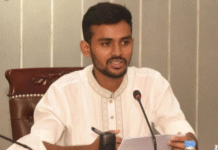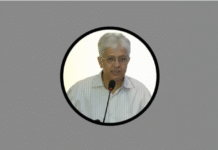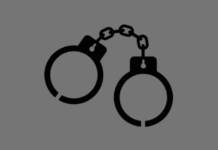Prothom Alo
In a recent visit, the 12km road from Abdullahpur intersection to Chandana intersection, particularly the stretch between Tongi Bazar and Cherag Ali, was found pitted with potholes.
After a project site visit by the bridge division secretary Abu Bakar Siddique on 19 June, a short-lived repair of the road was done.
Recently an ambulance driver Md Jakir Hossain shared his grief with Prothom Alo, saying that patient’s body jiggles on the stretcher due to the potholes in the road and the attendants blame him for rough driving.
The government, under the 20-year Strategic Transport Plan, drafted a construction project of 20km separate lane for rapid transport from the airport to Gazipur. Later the project plan was transformed into the BRT project that the Executive Committee of the National Economic Council approved on 1 December 2012. The project cost was initially estimated at Tk 20.4 billion (Tk 2,040 crore).
Asian Development Bank, French development agency AFD, Global Environment Facility and Bangladesh government are financing on the BRT project that was scheduled to be completed by the end of 2016.
However, the government has extended the project period (construction) to 2022. Due to the extension, revised estimation of the project cost now stands at Tk 42.68 billion (Tk 4,268 crore).
Officials concerned said that additional Tk 7.23 billion (Tk 723 crore) will need to procure the construction materials. Meanwhile, project consultants will charge extra for their additional services. Besides, inclusion of some project components has raised the budget requirement. And all of these happened because of the project delays.
However, negotiation with the development partners is going on as the government has yet not arranged the additional money to meet the revised budget.
Roads and highways department is implementing the structural development of BRT. Since its launching, the post of project director changed in six times. Additional chief engineer of RHD and the incumbent BRT project director ASM Elias Shah recently told Prothom Alo that the project has been delayed as the site is a busy road. Besides, land acquisition also consumed time.
Experts suggest that initial phase of a project requires a primary and a comprehensive feasibility studies to identify the challenges. Repeated changes in a project could be averted if the challenges are identified earlier.
According to ministry of road transport and bridges, ADB conducted a primary feasibility study on BRT in 2011. However, the construction phase started before finalising the architectural design over a comprehensive feasibility study. That’s why the project implementation faced unknown challenges. For example, there was no proper drainage system in the project site. It was also not planned earlier how the utility service lines will be relocated. Alternative route was not considered for the smooth movement of vehicles while working on the busy road.
The elevated ways under the BRT were planned to be set with box girders. Two years after the construction started, BRT contractors pushed the authorities to change the design so that the elevated ways are developed with pre-stressed concrete ‘I’ girders. The contractors said box girder-based elevated ways would occupy more spaces.
In 2019, an underpass was included into the design so that passersby are able to cross the Airport road safely. That inclusion added Tk 4.2 billion (Tk 420 crore) to the costs. The site chosen for caving an underpass was possessed separately by RHD, railway division and civil aviation authority. The land of Civil Aviation Authority is currently leased out to a private company while railway division and RHD are not willing to give their land. Hence, construction of the underpass cannot be started yet.
Four wings of the government: RHD, bridge division, local government engineering department (LGED) and Dhaka BRT Company, are involved in the BRT project. Besides four consultancy firms are also monitoring the project.
RHD is supervising the renovation as well as widening of 16km road, construction of BRT lanes, six elevated express ways, 25 BRT stations and the airport underpass. The bridge division is constructing a 4km elevated way with a BRT lane, station and a new 10-lane Tongi Bridge.
LGED has already completed its job. The government wing has constructed the linking roads and a bus depot in Gazipur, purchased solar energy-run traffic control equipment and street lamps.
The last phase of the project is related to BRT bus management, purchase of new buses, inclusion of private bus owners into BRT, smart operation and maintenance. Dhaka BRT Company is responsible for doing the works.
However, the government is temporarily halting the idea of new buses under BRT.
The government has done nothing but appointing a managing director and a secretary at Dhaka BRT Company. Its managing director Shafiqul Islam told Prothom Alo, “At the initial stage, BRT will operate the existing buses in a disciplined way. New buses will be included in future.”
There was a plan for developing another BRT from Keraniganj to the airport. However, the road transport and bridge minister Obaidul Qauder said last year that the government was not willing to go ahead with the second BRT.
Why BRT is crucial?
A feasibility study by Japan International Cooperation Agency (JICA) found in 2009 that an average travel speed of motorised vehicles was around 5km per hour in Dhaka where 67 per cent of passengers rode on public buses. Citing traffic congestion as the reason, the study report recommended for a BRT system that would facilitate a quick, safe, affordable and environment-friendly transportation of 20,000 passengers every hour.
The BRT system creates an isolated road within the existing one to allow free movement of designated buses.
BRT project is now a burden
Experts and the project officials concerned said implementation of such a BRT project would have taken maximum two years. But inclusion of several components including elevated ways, bridges and an underpass has made the project more complicated. Besides, the project would not yield full of its benefits with the exclusion of the Airport-Keraniganj part.
According to transport expert professor Shamsul Hoque, also a civil engineering teacher at Bangladesh University of Engineering and Technology, a BRT bus can transport passengers 10 times more than that of a conventional bus does.
“However, the already complicated BRT project has become a ‘burden’,” he told Prothom Alo.
[Gazipur correspondent contributed to filing the report]
*This report appeared in the print and online editions of Prothom Alo, has been rewritten in English by Sadiqur Rahman.










